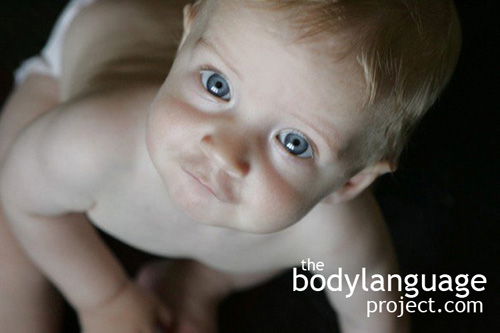 Babies are almost entirely dependant on nonverbal communication in their first few months, that is, if we discount crying! As children age, they still rely, as adults do, on nonverbal language such as pointing at a toy rather then asking for it, pushing other children aside when it suites them, or even hugs to show affection and exaggerated pouting to garner sympathy. Babies as young as nine month’s old, who lack verbal language, can even begin using sign language to convey desires showing just how rooted non-verbal communication is all of us.
Babies are almost entirely dependant on nonverbal communication in their first few months, that is, if we discount crying! As children age, they still rely, as adults do, on nonverbal language such as pointing at a toy rather then asking for it, pushing other children aside when it suites them, or even hugs to show affection and exaggerated pouting to garner sympathy. Babies as young as nine month’s old, who lack verbal language, can even begin using sign language to convey desires showing just how rooted non-verbal communication is all of us.
When young children lie they often have troubles making eye contact or they might hang their head, appear tense or they might even quickly pull both hands up and cover their mouths as if to shove the lie back in from where it came from. Even some adults will perform these gestures if they let slip a secret or particularly juicy piece of gossip in the wrong circle. However, at other times, both children and adults are not as obvious. A 2002 study by Victor Talwar and Kang Lee out of the University of Queens, Canada, however, showed that children as young as three are naturally adept at controlling their nonverbal language as it applies to deception. In the study, children were able to fool most of the evaluators of their deception as a videotape showing the lie was replayed. Children are not particularly skilled at lying through verbal channels though, and they slip up easily revealing inconsistencies in their stories, so this is where you can really catch them. We will cover deceptive body language at lengths later on.
Other emotional body language emitted by children is much more prevalent. For example, children use slouching and pouting to show that they are upset and disappointed but as we age, we drop our nonverbal cues in favour of verbal expression. We naturally become more adept at repressing what our bodies do and tend to use more conscious thought and spoken words since it is more direct and less easily misinterpreted. What starts off as a quick mouth slap movement to the mouth when lying (or swearing) in children, slowly becomes a touch to the corner of the mouth. Later, restraint forces the finger to the side even further and then instead of touching the mouth it touches the side of the nose instead. As people age, they become much more difficult to read. By logical progression, the hardest to read of all are sixty-year-old politicians!
As an interesting aside, dedicated parents even claim to be able to sense when a baby is about to relieve themselves and so avoid messy diapers. This technique is referred to as elimination communication. By reading gestures such as frowning, squirming, fussing or tensing, mother’s (or fathers!) in combination with baby’s particular rhythms, can detect when potty time is immanent. Once the baby’s cues have been deciphered the mother can anticipate potty time by holding baby over the toilet and cuing with “hiss-hiss” or “wiss-wiss” sounds. To associate the hissing sounds with urination, this process must be repeated ten to twenty times each day!
